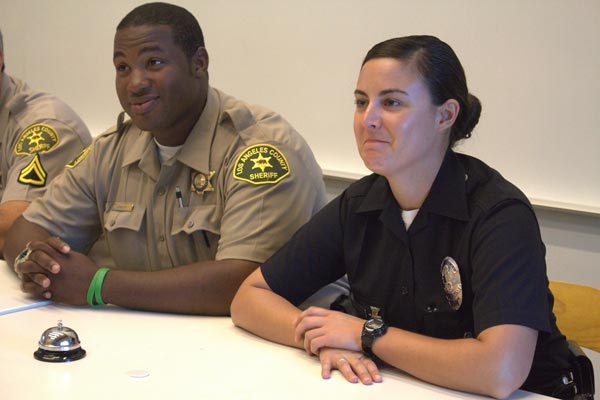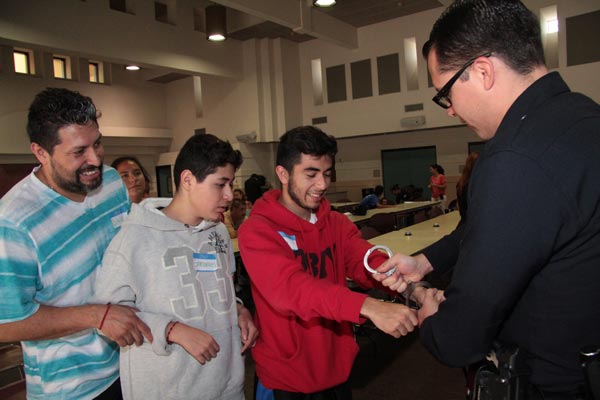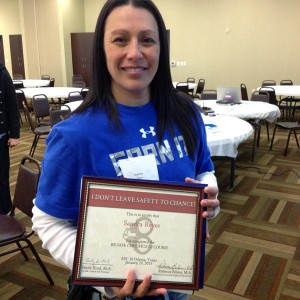What Training Option Works Best for You?
Book an Experience Autism Training Event
The Experience Autism® training can be booked as a stand-alone event in which the trainer facilitates the training with minimal support from the host organization. This is ideal for organizations with a limited budget or who wish to host a single training event.
Reach Out to the Special Needs Community with BE SAFE
There are two sides to the safety equation, training the police about autism and training individuals with autism how to interact safely with the police. Teaching safe behaviors directly and explicitly to teens and adults with ASD and similar conditions is essential for promoting safety during police encounters. We offer community safety training events based on BE SAFE The Movie. Bring a BE SAFE Interactive Screening and a BE SAFE Certificate Course to your community to help teens and adults with disabilities learn to interact safely with police while building mutual understanding and trust.
Experience Autism®
 The Experience Autism® training can be booked as a stand-alone event in which the trainer facilitates the training with minimal support from the host organization. This is ideal for organizations with a limited budget or who wish to host a single training event.
The Experience Autism® training can be booked as a stand-alone event in which the trainer facilitates the training with minimal support from the host organization. This is ideal for organizations with a limited budget or who wish to host a single training event.
Law enforcement agencies, city government or other organizations host an Experience Autism® training event for up to 50 personnel facilitated by program creator Emily Iland, M.A. Participants engage in 4 to 6 learning experiences that simulate what it is like to have Autism Spectrum Disorder (ASD). The event lasts from 2.5 to 3 hours and is eligible for education/training credits. The event activities are ideally experienced in small groups rotating through each activity, but other options can be arranged depending on the needs of the host department and the time allotted. Agencies can choose from six Experience Autism simulations. Custom simulations can be created upon request.
Presentation Objectives
- Recognize and understand the social-communication, behavioral and sensory features of Autism Spectrum Disorders
- Understand the point of view of people with ASD in different emergency situations
- Explore the use of specific techniques and tactical responses that may be helpful for interacting with individuals with ASD
- Improve outcomes and reduce risk during contact with individuals with ASD
Contact us for pricing and availability
BE SAFE Interactive Screening
 Many individuals with Autism Spectrum Disorders have unsafe or even disastrous encounters with law enforcement officials. Training the police about ASD is not enough. Teaching safe behaviors directly and explicitly to teens and adults with ASD and similar conditions is essential for promoting safety during police encounters.
Many individuals with Autism Spectrum Disorders have unsafe or even disastrous encounters with law enforcement officials. Training the police about ASD is not enough. Teaching safe behaviors directly and explicitly to teens and adults with ASD and similar conditions is essential for promoting safety during police encounters.
A BE SAFE Interactive Screening is a community event that teaches teens and adults with autism and related special needs how to interact safely with the police. The event is an excellent opportunity for law enforcement agencies to reach out to the Special Needs Community, coming together to improve mutual understanding and build skills.
The messages of safety, cooperation and boundaries learned at a BE SAFE Interactive Screenings are relevant to every teen and adult with special needs, and can even be life-saving.
The audience and police watch selected episodes of BE SAFE The Movie, an exciting new video modeling tool that shows what to do and say in different types of encounters with the police, ranging from a casual meeting to an arrest. They then do different safety activities together, focusing on skills like following instructions and asking for help.
- Actively promoting safety through a BE SAFE Interactive Screening can reduce risk and liability to police departments, and promote the safety of officers and community members.
- The event helps those with ASD related needs build and practice specific skills including: “Stay where you are when you meet the police,” “Follow all instructions from the police right away,” and “Always make sure the police can see your hands.”
- Police get to know local teens and adults with ASD and similar disabilities, their parents, caregivers, teachers, behaviorists, therapists, adult services staff, transition specialists, and school administrators. They have a chance to and skills to respond to special populations, meeting community policing goals.
Safety in police encounters can’t be left to chance. Who better to train young adults to be safe than police officers themselves? BE SAFE Interactive Screenings are hosted by law enforcement agencies, schools and community groups. The event lasts 2.5 hours and includes some unstructured time for interactions between law enforcement personnel and attendees at the end of the program. Events are offered (separately) in English or Spanish.
Presentation Objectives
- Explore key safety concepts that everyone must know, ranging from “What is a law?” to “The right to remain silent”
- Explore the expectations of the police in various encounters and help prepare individuals with ASD and similar disabilities to interact safely
- Learn and practice skills for interacting safely with the police
- Improve mutual understanding and comfort levels between the police and individuals with special needs
Note:
- To follow the Los Angeles Police Department’s Mission Possible model, officers who have participated in the Experience Autism® event also participate in a training event with teens and adults with ASD. The event gives officers an “eyes on” opportunity to apply what they learned in Experience Autism.
- Having trained personnel participate in this unique community outreach opportunity creates tremendous potential to build relationships and meet community policing goals.
- At Mission Possible event, officers were paired 1:1 with students with ASD; this is an ideal model. If necessary, a different ratio is also workable for a BE SAFE Interactive Screening
Contact us for pricing and availability
BE SAFE Certificate Course
 Parents, teachers, therapists, independent living staff, other professionals and even the police need effective tools to teaching safe behaviors directly and explicitly to teens and adults with Autism Spectrum Disorder, Intellectual/Developmental Disabilities, especially when it comes to promoting safety during police encounters.
Parents, teachers, therapists, independent living staff, other professionals and even the police need effective tools to teaching safe behaviors directly and explicitly to teens and adults with Autism Spectrum Disorder, Intellectual/Developmental Disabilities, especially when it comes to promoting safety during police encounters.
A BE SAFE Certificate Course is an engaging full-day interactive workshop that empowers participants with the information and tools they need to address the safety needs of teens and adults with Autism Spectrum Disorders, other developmental disabilities and individuals with similar learning needs.
Participants will learn how to effectively use BE SAFE Teaching Edition materials to teach essential safety skills to those with a wide range of abilities and disabilities. The course builds capacity for local educators, parents, law enforcement and individuals with disabilities (self-advocates) to assist with an initial BE SAFE Interactive Screening and expand outreach though additional BE SAFE screenings and related safety events.
- Participants will view all seven episodes of BE SAFE The Movie, an exciting new video modeling tool that helps prepare students for a safe and independent life. The 300-page Companion Curriculum will be explored in depth, including games, activities, resources and goals for transition. Participants will be prepared to make a difference in the life of teens and adults with exceptional needs, and receive a certificate of completion.
- The ideal audience for a BE SAFE Certificate Course consists of educators, service providers, organization leaders and others who wish to have direct training to effectively use the educational materials found in Be Safe Teaching Edition with transition-age students and adults.
- An excellent model is having “teams” from different schools or organizations train together so they can continue to collaborate to use the BE SAFE materials to reach individual learners, small groups, large groups or even entire student bodies. A dream team from each participating organization or school would include a special educator, a school resource officer or other law enforcement professional, a parent leader and a self-advocate.
Presentation Objectives
- Explore the key safety concepts that must be taught to teens/adults with special needs, ranging from “What is a law?” to “The right to remain silent.”
- Understand the effective use of video modeling as an evidence-based tool for teaching essential safety skills.
- Identify the expectations of the police in various encounters and help prepare individuals with special needs to interact safely
- Prepare participants to use BE SAFE materials at home, school or in community settings with individuals or groups.
- Select safety goals and teaching tools tailored of the needs of specific learners.
